Global Energy Drinks Market Forecast
- Global energy drinks market size to take a jump from US$86.9 Bn in 2022, to US$153.8 Bn by 2030-end
- Energy drinks market valuation likely to witness a strong CAGR of 8.5% between 2023 and 2030
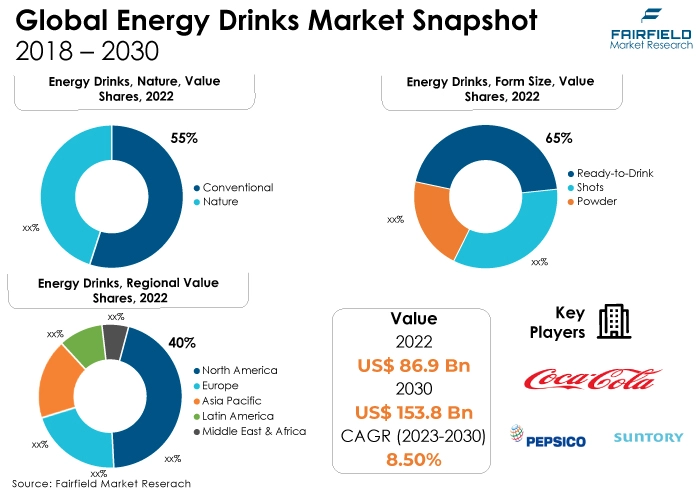
Quick Report Digest
- The key trend anticipated to fuel the global market for energy drinks growth is the increasing popularity of beverage applications.
- The energy drinks market is growing due to the rising demand for quick energy solutions, particularly among busy individuals and athletes. Aggressive marketing, innovative formulations, and diverse flavour options also contribute to its growth, as does the pursuit of healthier and functional energy drink alternatives.
- The ready-to-drink (RTD) form is poised to dominate the market for energy drinks due to its convenience, accessibility, and rapid consumption. RTD energy drinks require no preparation, making them the go-to choice for consumers seeking an immediate energy boost, driving their expected market leadership.
- Conventional energy drinks are projected to maintain the largest market share due to their long-standing presence and consumer familiarity. These beverages typically contain caffeine, sugar, and additional energy-boosting components, providing a reliable and recognised source of energy for a wide consumer base.
- Supermarkets and hypermarkets are expected to maintain the largest market share in the energy drinks industry due to their widespread presence, variety of product offerings, and consumers' preference for one-stop shopping. These retail channels offer convenience and accessibility, driving their anticipated dominance.
- North America is anticipated to maintain the largest market share in the energy drinks industry due to its established consumer base, high purchasing power, and strong demand for energy-boosting products. Aggressive marketing and product innovation have solidified the region's position as a dominant player in the global market.
- Asia Pacific is expected to achieve the highest CAGR in the energy drinks market due to its rapidly urbanising population, changing lifestyles, and increased demand for convenient energy solutions. Expanding retail infrastructure and the introduction of healthier variants further contribute to the region's anticipated growth.
- The regulatory landscape poses challenges to the market for energy drinks due to increasing scrutiny on caffeine content, labelling, and marketing practices. Concerns about potential health risks associated with excessive caffeine consumption have led to stricter regulations, impacting product formulation, marketing, and consumer perception.
A Look Back and a Look Forward - Comparative Analysis
The energy drinks market is growing due to the increasing demand for convenient, on-the-go energy solutions. Consumers seek beverages that offer a quick energy boost, making energy drinks appealing.
Marketing efforts highlighting the benefits of enhanced alertness and endurance, coupled with innovative flavours and formulations, continue to attract a diverse consumer base. Additionally, the market's expansion is driven by the rising preference for healthier and functional energy drink options.
The market for energy drinks is growing due to several factors. These include increasing consumer demand for quick energy boosts, especially among young adults and athletes. The market also benefits from aggressive marketing efforts, innovative product formulations, and a wide range of flavour options.
Moreover, the trend towards healthier and more natural ingredients, coupled with expanding distribution channels, contributes to the market's sustained growth.
The future of the market for energy drinks appears promising, with sustained growth expected. Factors such as consumers' busy lifestyles, demand for healthier and natural ingredients, and the introduction of innovative product variants will drive market expansion.
Additionally, a growing emphasis on sustainable packaging and reduced sugar content align with evolving consumer preferences, ensuring a dynamic and competitive landscape for energy drink companies.
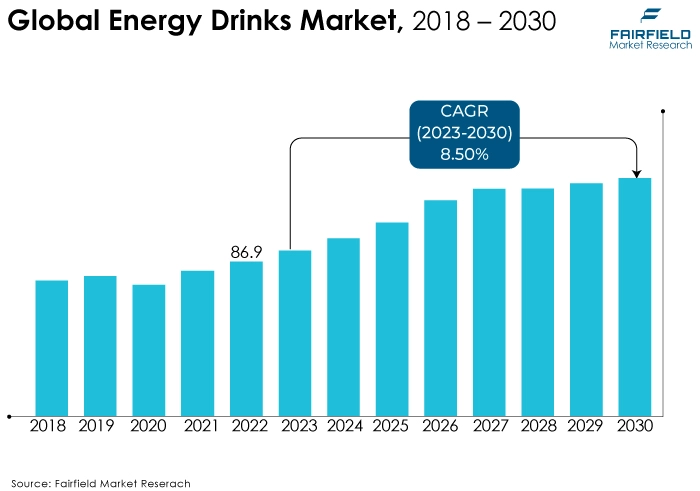
Key Growth Determinants
- Increasing Demand for Instant Energy Bosters
The market for energy drinks is witnessing robust growth primarily due to the increasing demand for products that offer instant energy solutions. Several factors contribute to this trend. Firstly, the fast-paced modern lifestyle often leads to fatigue and the need for quick energy replenishment, driving consumers towards energy drinks.
Athletes and individuals engaging in strenuous physical activities prefer energy drinks for their performance-enhancing benefits. Thirdly, aggressive marketing campaigns and endorsements by athletes and celebrities boost consumer awareness and appeal.
innovations in formulations, including caffeine content and added functional ingredients, cater to specific energy needs. As a result, the energy drinks market is set to continue its growth trajectory, fueled by the enduring demand for instant energy solutions in various consumer segments.
- Rise in Number of Athletes and Sports Persons
The surge in athletes and sports enthusiasts has become a significant driver for the market for energy drinks. These individuals turn to energy drinks to enhance their physical and mental performance, increase endurance, and combat fatigue during intense training sessions and competitions.
The endorsement of energy drinks by athletes and their availability at sporting events further amplifies their popularity. As a result, the sports-oriented consumer segment has become a vital growth factor in the market for energy drinks, driving increased consumption and product innovation.
- Increase in Disposable Income, and Changing Consumer Preferences
The market for energy drinks is benefiting from rising disposable incomes and evolving consumer preferences. With higher payments, consumers are more willing to spend on convenient and functional beverages like energy drinks.
Additionally, changing preferences towards healthier and more natural ingredients have led to the development of cleaner and better-for-you energy drink options. As a result, manufacturers are diversifying their product portfolios to cater to these changing tastes, driving increased consumption and overall market growth.
Major Growth Barriers
- Potential Risks
Risks associated with energy drink consumption pose a notable challenge to the industry. Concerns include potential health issues related to excessive caffeine intake, such as heart palpitations and nervousness.
Regulatory bodies and health experts have raised safety concerns, leading to restrictions and warning labels in some regions. Negative publicity and legal actions related to health incidents further tarnish the industry's reputation.
Overcoming these challenges requires companies to address safety concerns, promote responsible consumption, and innovate with healthier formulations to maintain consumer trust and market viability.
- Availability of Substitutes
The availability of substitutes is challenging the energy drinks market as consumers seek healthier alternatives. Functional beverages like natural fruit juices, herbal teas, and performance-enhancing supplements provide choices that offer sustained energy without the potential health risks associated with high caffeine content.
Moreover, the rising popularity of non-caffeinated and low-sugar energy alternatives poses a competitive threat. To address this challenge, energy drink manufacturers must innovate by offering healthier and more diverse product options that align with changing consumer preferences.
Key Trends and Opportunities to Look at
- Digital Marketing, and E-commerce
Digital marketing and e-commerce play a pivotal role in the market for energy drinks. Brands leverage online platforms and social media to engage with consumers, showcase product benefits, and run targeted advertising campaigns.
E-commerce platforms provide convenient and direct purchasing options, enabling customers to access a wide range of energy drink products and personalised offerings while also facilitating quick deliveries and subscription services, enhancing the overall customer experience.
- Clean Labelling
Clean labelling is a significant trend in the market for energy drinks, emphasizing transparency and natural ingredients. Brands are using clear, straightforward language on product labels to convey elements and nutritional information. This approach caters to health-conscious consumers seeking products with fewer artificial additives and chemicals.
Clean labelling aligns with the demand for more natural, health-oriented energy drink options, boosting consumer trust and loyalty.
- Smart Vending Machines
Smart vending machines are revolutionising the market for energy drinks by offering convenient and tech-savvy access to beverages. These machines feature digital payment options, touchscreen interfaces, and real-time inventory tracking.
These machines enhance customer convenience by providing a wide selection of energy drinks in various locations, including gyms, offices, and retail spaces, while also allowing brands to collect valuable data on consumer preferences and purchasing patterns for more targeted marketing efforts.
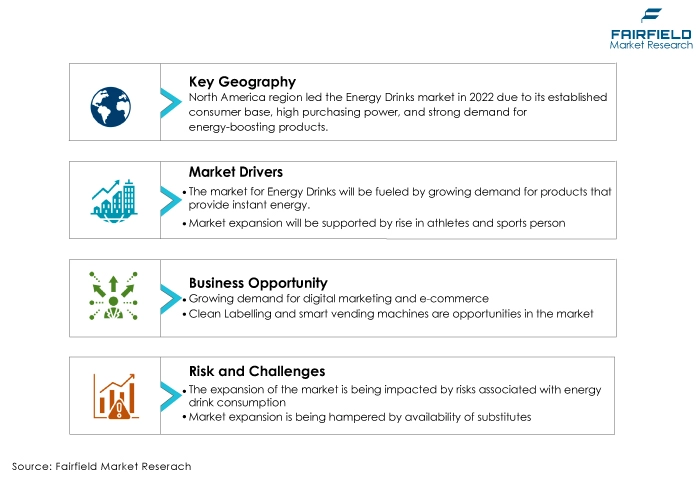
How Does the Regulatory Scenario Shape this Industry?
The regulatory scenario significantly influences the market for energy drinks. Regulatory bodies, like the US Food and Drug Administration (FDA), and the European Food Safety Authority (EFSA), set guidelines and limits on ingredients, labelling, and marketing practices. These regulations often focus on caffeine content, safety warnings, and nutritional labelling.
To comply with these regulations, companies may adjust their formulations, labelling, and marketing strategies. Additionally, some regions impose age restrictions on the sale of energy drinks to minors, addressing concerns about the potential health risks associated with excessive caffeine consumption.
The regulatory landscape continues to evolve, impacting product formulation, marketing, and consumer perception of energy drinks. Manufacturers must navigate these regulations to ensure product safety and compliance while meeting consumer demand for innovative and functional beverages.
Fairfield’s Ranking Board
Top Segments
- Ready-to-Drink Form Continue to Dominate
The ready-to-drink (RTD) form has secured the largest market share in the energy drinks segment due to its convenience and instant consumption appeal. RTD energy drinks are pre-packaged and require no preparation, making them readily available for on-the-go consumers seeking a quick energy boost. This form caters to busy lifestyles, providing a hassle-free option for those needing immediate refreshment and alertness.
Furthermore, the extensive availability and diverse flavour profiles of RTD energy drinks contribute to their dominance in the market. Energy drink shots are anticipated to experience the highest growth rate in the market due to their concentrated and potent nature. These small-sized shots pack a powerful punch of caffeine and other energy-boosting ingredients, appealing to consumers seeking a rapid energy surge without consuming a larger beverage.
Additionally, images are often marketed as quick, convenient, and suitable for busy individuals or athletes, aligning with the growing demand for functional and portable energy solutions, which is driving their expected growth in the market.
- Conventional Energy Drinks Remain Popular
Conventional energy drinks have captured the largest market share due to their well-established presence and consumer familiarity. These drinks typically contain a blend of caffeine, sugar, and additional energy-boosting ingredients, offering a familiar and reliable source of energy for a broad consumer base.
The conventional nature of these products, combined with extensive marketing efforts, has solidified their position in the market. While alternative and healthier options are emerging, traditional energy drinks continue to enjoy widespread popularity among consumers seeking quick and accessible energy solutions.
Organic energy drinks are projected to experience the highest CAGR in the market due to the increasing consumer demand for healthier and more natural energy options. These products are formulated with organic and clean-label ingredients, devoid of artificial additives and excessive sugar.
As consumers prioritise wellbeing and sustainability, organic energy drinks align with these preferences, driving their expected growth. The trend towards cleaner, more sustainable, and transparent beverage choices positions organic energy drinks as a key driver in the evolving market landscape.
- Supermarkets/Hypermarkets Account for the Highest Sales
Supermarkets and hypermarkets have secured the largest market share in the energy drinks distribution channels due to their widespread presence and extensive product offerings. These retail giants offer a diverse range of energy drink brands and flavours, attracting a broad consumer base.
The convenience of one-stop shopping, competitive pricing, and the ability to stock a variety of energy drinks contribute to their dominance. Additionally, consumers often prefer physically browsing and selecting energy drinks, making these brick-and-mortar stores a popular choice for energy drink purchases.
Online retail is expected to achieve the highest CAGR in the market for energy drinks due to the increasing popularity of e-commerce platforms. Consumers increasingly prefer the convenience of online shopping, enabling them to access a wide variety of energy drink brands and flavours from the comfort of their homes.
Online retailers offer competitive pricing, subscription services, and the ability to reach niche markets effectively. The growing digitalisation of sales channels and the ease of home delivery are driving the expected surge in online retail's market share.
Regional Frontrunners
North America Contributes the Largest Market Share
North America has captured the largest market share in the energy drinks industry for several reasons. Firstly, the region has a well-established culture of consuming energy beverages, with consumers seeking quick energy boosts to combat their busy lifestyles.
Aggressive marketing campaigns and endorsements by athletes and celebrities have contributed to the widespread popularity of these products. Thirdly, North America has been at the forefront of product innovation, introducing a variety of flavours, formulations, and functional ingredients to cater to evolving consumer preferences.
Additionally, the region's diverse distribution channels, including convenience stores, supermarkets, and online retail, ensure widespread availability. Lastly, the presence of major industry players, robust consumer purchasing power, and a willingness to try new energy drink variants have all contributed to North America's dominance in the global energy drinks market.
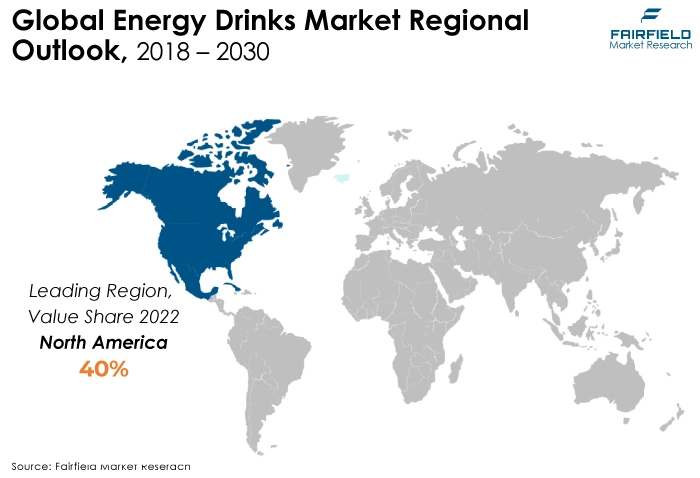
Asia Pacific Anticipates a Solid CAGR Through 2030
Asia Pacific is poised to achieve the highest CAGR in the market for energy drinks due to several factors. Rapid urbanisation, a burgeoning young population, and changing lifestyles have increased the demand for quick energy solutions in the region.
Additionally, expanding retail infrastructure and e-commerce platforms have made energy drinks more accessible. As consumers become increasingly health-conscious, the introduction of healthier and functional variants aligns with their preferences, contributing to the expected growth of the energy drinks market in Asia Pacific.
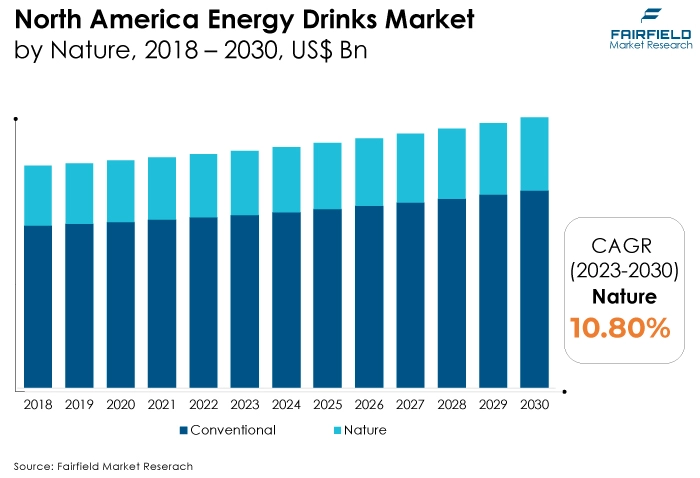
Fairfield’s Competitive Landscape Analysis
The global energy drinks market is a consolidated market with fewer major players present globally. The key players are introducing new products and working on the distribution channels to enhance their worldwide presence. Moreover, Fairfield Market Research expects more consolidation over the coming years.
Who are the Leaders in the Global Energy Drinks Space?
- Red Bull GmBH
- Monster Beverage Corporation
- PepsiCo
- The Coca Cola
- Rockstar Inc.
- 5-hour Energy
- Abbott Nutrition
- National Beverage Corporation
- Celsius Holdings
- Keurig Dr Pepper
- Xyience
- Reign Total Body Fuel
- Guru Organic Energy
- Hiball Energy
- Suntory Beverage & Food Ltd
Significant Company Developments
New Product Launches
- March 2023: Red Bull introduced its Summer Edition line featuring a new Juneberry-flavoured energy drink in the United Kingdom. The company has stated that these Juneberry beverages are now accessible in various major retailers throughout the country, offering both single and multipack options.
- October 2022: Red Bull has entered into a strategic partnership with Keurig Dr. Pepper for the distribution and sale of its products throughout Mexico.
Distribution Agreement
- September 2022: Coca-Cola Europacific Partners (CCEP) expanded its Monster product line with the introduction of two new flavours aimed at attracting a wider range of consumers. These additions, Monster Reserve White Pineapple and Monster Reserve Watermelon have joined the company's existing traditional energy drink offerings.
An Expert’s Eye
Demand and Future Growth
As per Fairfield’s Analysis, growth in the beverage sector is driving the market. The market demand for energy drinks remains strong due to consumers' need for quick energy boosts, especially in hectic lifestyles. Future growth is expected as manufacturers innovate with healthier and more natural ingredients to meet changing consumer preferences.
The market will likely expand its product range to cater to various health-conscious segments. As the focus on fitness and wellness continues to rise, energy drinks will evolve to offer functional benefits, ensuring sustained demand and growth in the coming years.
Supply Side of the Market
The leading countries in the energy drinks market include the United States, where energy drinks are deeply ingrained in the culture, and Canada, both characterised by high consumer demand and numerous product options. In Europe, the United Kingdom, and Germany have significant market shares due to consumer preferences for energy-boosting beverages.
The Asia Pacific region, particularly China, and Japan, is also a growing market driven by urbanisation and changing lifestyles. These countries collectively dominate the global market for energy drinks, accounting for substantial shares of consumption and revenue.
The primary raw materials in energy drinks include water, caffeine, sugar or sweeteners, flavourings, and functional additives like vitamins, and amino acids. Additionally, ingredients like taurine and ginseng may be used.
Major suppliers of these raw materials vary but often include multinational suppliers like Cargill, Tate & Lyle, and Archer Daniels Midland Company for sweeteners; flavour houses like Givaudan and International Flavours & Fragrances Inc. (IFF), and caffeine suppliers such as CSPC Pharmaceutical Group, and Suzhou Pharma for production of energy drinks.
Global Global Energy Drinks Market is Segmented as Below:
By Form:
- Shots
- Ready-to-Drink
- Powder
By Nature:
- Organic
- Conventional
By Distribution Channel:
- Supermarket/Hypermarkets
- Convenience Stores
- Independent Small Groceries
- Online Retail
By Geographic Coverage:
- North America
- U.S.
- Canada
- Europe
- Germany
- U.K.
- France
- Italy
- Turkey
- Russia
- Rest of Europe
- Asia Pacific
- China
- Japan
- South Korea
- India
- Southeast Asia
- Rest of Asia Pacific
- Latin America
- Brazil
- Mexico
- Argentina
- Rest of Latin America
- Middle East & Africa
- GCC
- South Africa
- Egypt
- Nigeria
- Rest of the Middle East & Africa
1. Executive Summary
1.1. Global Energy Drinks Market Snapshot
1.2. Future Projections
1.3. Key Market Trends
1.4. Regional Snapshot, by Value, 2022
1.5. Analyst Recommendations
2. Market Overview
2.1. Market Definitions and Segmentations
2.2. Market Dynamics
2.2.1. Drivers
2.2.2. Restraints
2.2.3. Market Opportunities
2.3. Value Chain Analysis
2.4. Porter’s Five Forces Analysis
2.5. Covid-19 Impact Analysis
2.5.1. Supply
2.5.2. Demand
2.6. Impact of Ukraine-Russia Conflict
2.7. Economic Overview
2.7.1. World Economic Projections
2.8. PESTLE Analysis
3. Global Energy Drinks Market Outlook, 2018 - 2030
3.1. Global Energy Drinks Market Outlook, by Form, Value (US$ Bn), 2018 - 2030
3.1.1. Key Highlights
3.1.1.1. Shots
3.1.1.2. Ready-to-Drink
3.1.1.3. Powder
3.2. Global Energy Drinks Market Outlook, by Nature, Value (US$ Bn), 2018 - 2030
3.2.1. Key Highlights
3.2.1.1. Organic
3.2.1.2. Conventional
3.3. Global Energy Drinks Market Outlook, by Distribution Channel, Value (US$ Bn), 2018 - 2030
3.3.1. Key Highlights
3.3.1.1. Supermarket/Hypermarkets
3.3.1.2. Convenience Stores
3.3.1.3. Independent Small Groceries
3.3.1.4. Online Retail
3.4. Global Energy Drinks Market Outlook, by Region, Value (US$ Bn), 2018 - 2030
3.4.1. Key Highlights
3.4.1.1. North America
3.4.1.2. Europe
3.4.1.3. Asia Pacific
3.4.1.4. Latin America
3.4.1.5. Middle East & Africa
4. North America Energy Drinks Market Outlook, 2018 - 2030
4.1. North America Energy Drinks Market Outlook, by Form, Value (US$ Bn), 2018 - 2030
4.1.1. Key Highlights
4.1.1.1. Shots
4.1.1.2. Ready-to-Drink
4.1.1.3. Powder
4.2. North America Energy Drinks Market Outlook, by Nature, Value (US$ Bn), 2018 - 2030
4.2.1. Key Highlights
4.2.1.1. Organic
4.2.1.2. Conventional
4.3. North America Energy Drinks Market Outlook, by Distribution Channel, Value (US$ Bn), 2018 - 2030
4.3.1. Key Highlights
4.3.1.1. Supermarket/Hypermarkets
4.3.1.2. Convenience Stores
4.3.1.3. Independent Small Groceries
4.3.1.4. Online Retail
4.3.2. BPS Analysis/Market Attractiveness Analysis
4.4. North America Energy Drinks Market Outlook, by Country, Value (US$ Bn), 2018 - 2030
4.4.1. Key Highlights
4.4.1.1. U.S. Energy Drinks Market by Form, Value (US$ Bn), 2018 - 2030
4.4.1.2. U.S. Energy Drinks Market Nature, Value (US$ Bn), 2018 - 2030
4.4.1.3. U.S. Energy Drinks Market Distribution Channel, Value (US$ Bn), 2018 - 2030
4.4.1.4. U.S. Energy Drinks Market End Use, Value (US$ Bn), 2018 - 2030
4.4.1.5. Canada Energy Drinks Market by Form, Value (US$ Bn), 2018 - 2030
4.4.1.6. Canada Energy Drinks Market Nature, Value (US$ Bn), 2018 - 2030
4.4.1.7. Canada Energy Drinks Market Distribution Channel, Value (US$ Bn), 2018 - 2030
4.4.1.8. Canada Energy Drinks Market End Use, Value (US$ Bn), 2018 - 2030
4.4.2. BPS Analysis/Market Attractiveness Analysis
5. Europe Energy Drinks Market Outlook, 2018 - 2030
5.1. Europe Energy Drinks Market Outlook, by Form, Value (US$ Bn), 2018 - 2030
5.1.1. Key Highlights
5.1.1.1. Shots
5.1.1.2. Ready-to-Drink
5.1.1.3. Powder
5.2. Europe Energy Drinks Market Outlook, by Nature, Value (US$ Bn), 2018 - 2030
5.2.1. Key Highlights
5.2.1.1. Organic
5.2.1.2. Conventional
5.3. Europe Energy Drinks Market Outlook, by Distribution Channel, Value (US$ Bn), 2018 - 2030
5.3.1. Key Highlights
5.3.1.1. Supermarket/Hypermarkets
5.3.1.2. Convenience Stores
5.3.1.3. Independent Small Groceries
5.3.1.4. Online Retail
5.3.2. BPS Analysis/Market Attractiveness Analysis
5.4. Europe Energy Drinks Market Outlook, by Country, Value (US$ Bn), 2018 - 2030
5.4.1. Key Highlights
5.4.1.1. Germany Energy Drinks Market by Form, Value (US$ Bn), 2018 - 2030
5.4.1.2. Germany Energy Drinks Market Nature, Value (US$ Bn), 2018 - 2030
5.4.1.3. Germany Energy Drinks Market Distribution Channel, Value (US$ Bn), 2018 - 2030
5.4.1.4. U.K. Energy Drinks Market by Form, Value (US$ Bn), 2018 - 2030
5.4.1.5. U.K. Energy Drinks Market Nature, Value (US$ Bn), 2018 - 2030
5.4.1.6. U.K. Energy Drinks Market Distribution Channel, Value (US$ Bn), 2018 - 2030
5.4.1.7. France Energy Drinks Market by Form, Value (US$ Bn), 2018 - 2030
5.4.1.8. France Energy Drinks Market Nature, Value (US$ Bn), 2018 - 2030
5.4.1.9. France Energy Drinks Market Distribution Channel, Value (US$ Bn), 2018 - 2030
5.4.1.10. Italy Energy Drinks Market by Form, Value (US$ Bn), 2018 - 2030
5.4.1.11. Italy Energy Drinks Market Nature, Value (US$ Bn), 2018 - 2030
5.4.1.12. Italy Energy Drinks Market Distribution Channel, Value (US$ Bn), 2018 - 2030
5.4.1.13. Turkey Energy Drinks Market by Form, Value (US$ Bn), 2018 - 2030
5.4.1.14. Turkey Energy Drinks Market Nature, Value (US$ Bn), 2018 - 2030
5.4.1.15. Turkey Energy Drinks Market Distribution Channel, Value (US$ Bn), 2018 - 2030
5.4.1.16. Russia Energy Drinks Market by Form, Value (US$ Bn), 2018 - 2030
5.4.1.17. Russia Energy Drinks Market Nature, Value (US$ Bn), 2018 - 2030
5.4.1.18. Russia Energy Drinks Market Distribution Channel, Value (US$ Bn), 2018 - 2030
5.4.1.19. Rest of Europe Energy Drinks Market by Form, Value (US$ Bn), 2018 - 2030
5.4.1.20. Rest of Europe Energy Drinks Market Nature, Value (US$ Bn), 2018 - 2030
5.4.1.21. Rest of Europe Energy Drinks Market Distribution Channel, Value (US$ Bn), 2018 - 2030
5.4.2. BPS Analysis/Market Attractiveness Analysis
6. Asia Pacific Energy Drinks Market Outlook, 2018 - 2030
6.1. Asia Pacific Energy Drinks Market Outlook, by Form, Value (US$ Bn), 2018 - 2030
6.1.1. Key Highlights
6.1.1.1. Shots
6.1.1.2. Ready-to-Drink
6.1.1.3. Powder
6.2. Asia Pacific Energy Drinks Market Outlook, by Nature, Value (US$ Bn), 2018 - 2030
6.2.1. Key Highlights
6.2.1.1. Organic
6.2.1.2. Conventional
6.3. Asia Pacific Energy Drinks Market Outlook, by Distribution Channel, Value (US$ Bn), 2018 - 2030
6.3.1. Key Highlights
6.3.1.1. Supermarket/Hypermarkets
6.3.1.2. Convenience Stores
6.3.1.3. Independent Small Groceries
6.3.1.4. Online Retail
6.3.2. BPS Analysis/Market Attractiveness Analysis
6.4. Asia Pacific Energy Drinks Market Outlook, by Country, Value (US$ Bn), 2018 - 2030
6.4.1. Key Highlights
6.4.1.1. China Energy Drinks Market by Form, Value (US$ Bn), 2018 - 2030
6.4.1.2. China Energy Drinks Market Nature, Value (US$ Bn), 2018 - 2030
6.4.1.3. China Energy Drinks Market Distribution Channel, Value (US$ Bn), 2018 - 2030
6.4.1.4. Japan Energy Drinks Market by Form, Value (US$ Bn), 2018 - 2030
6.4.1.5. Japan Energy Drinks Market Nature, Value (US$ Bn), 2018 - 2030
6.4.1.6. Japan Energy Drinks Market Distribution Channel, Value (US$ Bn), 2018 - 2030
6.4.1.7. South Korea Energy Drinks Market by Form, Value (US$ Bn), 2018 - 2030
6.4.1.8. South Korea Energy Drinks Market Nature, Value (US$ Bn), 2018 - 2030
6.4.1.9. South Korea Energy Drinks Market Distribution Channel, Value (US$ Bn), 2018 - 2030
6.4.1.10. India Energy Drinks Market by Form, Value (US$ Bn), 2018 - 2030
6.4.1.11. India Energy Drinks Market Nature, Value (US$ Bn), 2018 - 2030
6.4.1.12. India Energy Drinks Market Distribution Channel, Value (US$ Bn), 2018 - 2030
6.4.1.13. Southeast Asia Energy Drinks Market by Form, Value (US$ Bn), 2018 - 2030
6.4.1.14. Southeast Asia Energy Drinks Market Nature, Value (US$ Bn), 2018 - 2030
6.4.1.15. Southeast Asia Energy Drinks Market Distribution Channel, Value (US$ Bn), 2018 - 2030
6.4.1.16. Rest of Asia Pacific Energy Drinks Market by Form, Value (US$ Bn), 2018 - 2030
6.4.1.17. Rest of Asia Pacific Energy Drinks Market Nature, Value (US$ Bn), 2018 - 2030
6.4.1.18. Rest of Asia Pacific Energy Drinks Market Distribution Channel, Value (US$ Bn), 2018 - 2030
6.4.2. BPS Analysis/Market Attractiveness Analysis
7. Latin America Energy Drinks Market Outlook, 2018 - 2030
7.1. Latin America Energy Drinks Market Outlook, by Form, Value (US$ Bn), 2018 - 2030
7.1.1. Key Highlights
7.1.1.1. Shots
7.1.1.2. Ready-to-Drink
7.1.1.3. Powder
7.2. Latin America Energy Drinks Market Outlook, by Nature, Value (US$ Bn), 2018 - 2030
7.2.1. Key Highlights
7.2.1.1. Organic
7.2.1.2. Conventional
7.3. Latin America Energy Drinks Market Outlook, by Distribution Channel, Value (US$ Bn), 2018 - 2030
7.3.1. Key Highlights
7.3.1.1. Supermarket/Hypermarkets
7.3.1.2. Convenience Stores
7.3.1.3. Independent Small Groceries
7.3.1.4. Online Retail
7.3.2. BPS Analysis/Market Attractiveness Analysis
7.4. Latin America Energy Drinks Market Outlook, by Country, Value (US$ Bn), 2018 - 2030
7.4.1. Key Highlights
7.4.1.1. Brazil Energy Drinks Market by Form, Value (US$ Bn), 2018 - 2030
7.4.1.2. Brazil Energy Drinks Market Nature, Value (US$ Bn), 2018 - 2030
7.4.1.3. Brazil Energy Drinks Market Distribution Channel, Value (US$ Bn), 2018 - 2030
7.4.1.4. Mexico Energy Drinks Market by Form, Value (US$ Bn), 2018 - 2030
7.4.1.5. Mexico Energy Drinks Market Nature, Value (US$ Bn), 2018 - 2030
7.4.1.6. Mexico Energy Drinks Market Distribution Channel, Value (US$ Bn), 2018 - 2030
7.4.1.7. Argentina Energy Drinks Market by Form, Value (US$ Bn), 2018 - 2030
7.4.1.8. Argentina Energy Drinks Market Nature, Value (US$ Bn), 2018 - 2030
7.4.1.9. Argentina Energy Drinks Market Distribution Channel, Value (US$ Bn), 2018 - 2030
7.4.1.10. Rest of Latin America Energy Drinks Market by Form, Value (US$ Bn), 2018 - 2030
7.4.1.11. Rest of Latin America Energy Drinks Market Nature, Value (US$ Bn), 2018 - 2030
7.4.1.12. Rest of Latin America Energy Drinks Market Distribution Channel, Value (US$ Bn), 2018 - 2030
7.4.2. BPS Analysis/Market Attractiveness Analysis
8. Middle East & Africa Energy Drinks Market Outlook, 2018 - 2030
8.1. Middle East & Africa Energy Drinks Market Outlook, by Form, Value (US$ Bn), 2018 - 2030
8.1.1. Key Highlights
8.1.1.1. Shots
8.1.1.2. Ready-to-Drink
8.1.1.3. Powder
8.2. Middle East & Africa Energy Drinks Market Outlook, by Nature, Value (US$ Bn), 2018 - 2030
8.2.1. Key Highlights
8.2.1.1. Organic
8.2.1.2. Conventional
8.3. Middle East & Africa Energy Drinks Market Outlook, by Distribution Channel, Value (US$ Bn), 2018 - 2030
8.3.1. Key Highlights
8.3.1.1. Supermarket/Hypermarkets
8.3.1.2. Convenience Stores
8.3.1.3. Independent Small Groceries
8.3.1.4. Online Retail
8.3.2. BPS Analysis/Market Attractiveness Analysis
8.4. Middle East & Africa Energy Drinks Market Outlook, by Country, Value (US$ Bn), 2018 - 2030
8.4.1. Key Highlights
8.4.1.1. GCC Energy Drinks Market by Form, Value (US$ Bn), 2018 - 2030
8.4.1.2. GCC Energy Drinks Market Nature, Value (US$ Bn), 2018 - 2030
8.4.1.3. GCC Energy Drinks Market Distribution Channel, Value (US$ Bn), 2018 - 2030
8.4.1.4. South Africa Energy Drinks Market by Form, Value (US$ Bn), 2018 - 2030
8.4.1.5. South Africa Energy Drinks Market Nature, Value (US$ Bn), 2018 - 2030
8.4.1.6. South Africa Energy Drinks Market Distribution Channel, Value (US$ Bn), 2018 - 2030
8.4.1.7. Egypt Energy Drinks Market by Form, Value (US$ Bn), 2018 - 2030
8.4.1.8. Egypt Energy Drinks Market Nature, Value (US$ Bn), 2018 - 2030
8.4.1.9. Egypt Energy Drinks Market Distribution Channel, Value (US$ Bn), 2018 - 2030
8.4.1.10. Nigeria Energy Drinks Market by Form, Value (US$ Bn), 2018 - 2030
8.4.1.11. Nigeria Energy Drinks Market Nature, Value (US$ Bn), 2018 - 2030
8.4.1.12. Nigeria Energy Drinks Market Distribution Channel, Value (US$ Bn), 2018 - 2030
8.4.1.13. Rest of Middle East & Africa Energy Drinks Market by Form, Value (US$ Bn), 2018 - 2030
8.4.1.14. Rest of Middle East & Africa Energy Drinks Market Nature, Value (US$ Bn), 2018 - 2030
8.4.1.15. Rest of Middle East & Africa Energy Drinks Market Distribution Channel, Value (US$ Bn), 2018 - 2030
8.4.2. BPS Analysis/Market Attractiveness Analysis
9. Competitive Landscape
9.1. End-User vs Application Heatmap
9.2. Manufacturer vs Application Heatmap
9.3. Company Market Share Analysis, 2022
9.4. Competitive Dashboard
9.5. Company Profiles
9.5.1. Red Bull GmbH
9.5.1.1. Company Overview
9.5.1.2. Product Portfolio
9.5.1.3. Financial Overview
9.5.1.4. Business Strategies and Development
9.5.2. Monster Beverage Corporation
9.5.2.1. Company Overview
9.5.2.2. Product Portfolio
9.5.2.3. Financial Overview
9.5.2.4. Business Strategies and Development
9.5.3. PepsiCo, Inc.
9.5.3.1. Company Overview
9.5.3.2. Product Portfolio
9.5.3.3. Financial Overview
9.5.3.4. Business Strategies and Development
9.5.4. The Coca-Cola Company
9.5.4.1. Company Overview
9.5.4.2. Product Portfolio
9.5.4.3. Financial Overview
9.5.4.4. Business Strategies and Development
9.5.5. Rockstar, Inc.
9.5.5.1. Company Overview
9.5.5.2. Product Portfolio
9.5.5.3. Financial Overview
9.5.5.4. Business Strategies and Development
9.5.6. 5-hour Energy
9.5.6.1. Company Overview
9.5.6.2. Product Portfolio
9.5.6.3. Financial Overview
9.5.6.4. Business Strategies and Development
9.5.7. Abbott Nutrition
9.5.7.1. Company Overview
9.5.7.2. Product Portfolio
9.5.7.3. Financial Overview
9.5.7.4. Business Strategies and Development
9.5.8. National Beverage Corp.
9.5.8.1. Company Overview
9.5.8.2. Product Portfolio
9.5.8.3. Financial Overview
9.5.8.4. Business Strategies and Development
9.5.9. Celsius Holdings, Inc.
9.5.9.1. Company Overview
9.5.9.2. Product Portfolio
9.5.9.3. Financial Overview
9.5.9.4. Business Strategies and Development
9.5.10. Keurig Dr Pepper Inc.
9.5.10.1. Company Overview
9.5.10.2. Product Portfolio
9.5.10.3. Financial Overview
9.5.10.4. Business Strategies and Development
9.5.11. Xyience
9.5.11.1. Company Overview
9.5.11.2. Product Portfolio
9.5.11.3. Financial Overview
9.5.11.4. Business Strategies and Development
9.5.12. Reign Total Body Fuel
9.5.12.1. Company Overview
9.5.12.2. Product Portfolio
9.5.12.3. Financial Overview
9.5.12.4. Business Strategies and Development
9.5.13. Guru Organic Energy
9.5.13.1. Company Overview
9.5.13.2. Product Portfolio
9.5.13.3. Financial Overview
9.5.13.4. Business Strategies and Development
9.5.14. Hiball Energy
9.5.14.1. Company Overview
9.5.14.2. Product Portfolio
9.5.14.3. Financial Overview
9.5.14.4. Business Strategies and Development
9.5.15. Suntory Beverage & Food Ltd
9.5.15.1. Company Overview
9.5.15.2. Product Portfolio
9.5.15.3. Financial Overview
9.5.15.4. Business Strategies and Development
10. Appendix
10.1. Research Methodology
10.2. Report Assumptions
10.3. Acronyms and Abbreviations
|
BASE YEAR |
HISTORICAL DATA |
FORECAST PERIOD |
UNITS |
|||
|
2022 |
|
2018 - 2022 |
2023 - 2030 |
Value: US$ Million |
||
|
REPORT FEATURES |
DETAILS |
|
Form Coverage |
|
|
Nature Coverage |
|
|
Distribution Channel Coverage |
|
|
Geographical Coverage |
|
|
Leading Companies |
|
|
Report Highlights |
Key Market Indicators, Macro-micro economic impact analysis, Technological Roadmap, Key Trends, Driver, Restraints, and Future Opportunities & Revenue Pockets, Porter’s 5 Forces Analysis, Historical Trend (2019-2021), Market Estimates and Forecast, Market Dynamics, Industry Trends, Competition Landscape, Category, Region, Country- wise Trends & Analysis, COVID-19 Impact Analysis (Demand and Supply Chain) |
